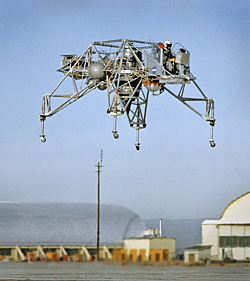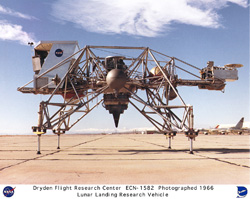Lunar Landing Research Vehicle

An LLRV at Edwards AFB, undergoing tests.

Stationary LLRV at Dryden Flight Research Center.
The Lunar Landing Research Vehicle (LLRV) was a flying contraption used by American astronauts as part of their training in how to control the Apollo Lunar Module (LM) during descents to the surface of the Moon. It had a weight distribution and throttle reaction time similar to that of the real LM and a downward-facing turbofan engine to provide vertical thrust.
The LLRV was based around earlier experimental VTOL vehicles, such as the Rolls-Royce Thrust-Measuring Rig (TMR), developed to study the potential of vertical takeoff and landing for jet aircraft. Like the TMR, the LLRV was known as a "flying bedstead". Neil Armstrong had a narrow escape when the LLRV he was flying went out of control and he was forced to eject.
History of the LLRV
The idea for the LLRV dates back to about 1960 when NASA started planning for the Apollo missions which would take humans to the Moon. It was critical that astronauts be able to train in a free-flying craft that handled in a similar way to the descent vehicle that would be piloted down to the lunar surface. After conceptual planning, contracts were awarded to Bell Aerosystems, first to study and then to produce the LLRV. Two vehicles were delivered by Bell to NASA's Flight Research Center (which eventually became Dryden Flight Research Center) in 1964. The first actual flights were carried out at Edwards Air Force Base, beginning in October 1964, with three short flights by Joe Walker, totaling just over a minute to no more than 10 feet above the ground.
By mid-1966, NASA had learned enough from the LLRV program to award Bell a contract for three Lunar Landing Test Vehicles (LLTVs) which more closely modeled the flight characteristics and controls of the actual Lunar Module. Of the five-strong fleet used to train astronauts, three were destroyed in crashes at the Manned Space Flight Center, Houston – LLRV No. 1 in May 1968 and two LLTVs, in December 1968 and January 1971. Fortunately, in each case the pilot was able to eject safely. The flight on which LLRV No. 1 was lost was piloted by Neil Armstrong, who later became the first person to walk on the Moon.
Construction of the LLRV
Built of aluminum alloy trusses, the LLRV was powered by a General Electric CF-700-2V turbofan engine, with 4,200 pounds of thrust, mounted vertically in a gimbal The engine got the vehicle up to the test altitude and was then throttled back to support five-sixths of the vehicle's weight, simulating the reduced gravity of the Moon. Two hydrogen peroxide lift rockets with thrust that could be varied from 100 to 500 pounds handled the LLRV's rate of descent and horizontal movement. Sixteen smaller hydrogen peroxide rockets, mounted in pairs, gave the pilot control in pitch, yaw and roll. As safety backups on the LLRV, six 500-pound rockets could take over the lift function and stabilize the craft for a moment if the main jet engine failed. The pilot had a zero-zero ejection seat that would then lift him away to safety.


